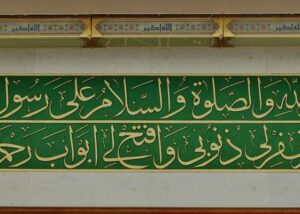Can women pray in rows parallel to men?
Quran
Hadith
Islamic Text
This must be avoided. Firstly, it contradicts the Sunnah by agreement. Secondly, the prayer of the men behind the women’s rows are invalidated according to many leading Hanafi Imams.
عَنْ أَبِي هُرَيْرَةَ، قَالَ: قَالَ رَسُولُ اللهِ صَلَّى اللهُ عَلَيْهِ وَسَلَّمَ: خَيْرُ صُفُوفِ الرِّجَالِ أَوَّلُهَا، وَشَرُّهَا آخِرُهَا، وَخَيْرُ صُفُوفِ النِّسَاءِ آخِرُهَا، وَشَرُّهَا أَوَّلُهَا
(Sayidina) Abu Hurairah (May Allah be pleased with him) said, the Messenger of Allah (ﷺ) said, ‘The best of the men’s rows (in Salah) is the first row and the worst is the last. And the best of the woman’s rows is the last and the worst of their rows is the first.’ (Sahih Muslim, 440 – 132).
As we see in the Hadith above the Sunnah is to arrange the rows such that the women pray in rows that are behind the men. This is well established and agreed upon. Therefore, allocating a room to women that is parallel with the men’s rows is in contradiction with the Sunnah.
As well as contradicting the Sunnah there is a greater concern with such an arrangement according to leading Imams of the Hanafi Madhab. They explained that men praying behind a row of women jeopardises the validity of their Salah.
ثُمَّ الْوَاحِدَةُ تُفْسِدُ صَلَاةَ ثَلَاثَةٍ وَاحِدٍ عَنْ يَمِينِهَا وَآخَرَ عَنْ شِمَالِهَا وَآخَرَ خَلْفَهَا لَيْسَ غَيْرُ، فَإِنَّ مَنْ فَسَدَتْ صَلَاتُهُ يَصِيرُ حَائِلًا بَيْنَهَا وَبَيْنَ الَّذِي يَلِيهِ وَالْمَرْأَتَانِ صَلَاةَ أَرْبَعَةٍ اثْنَيْنِ خَلْفَهُمَا وَالْآخَرَيْنِ لِأَنَّ الْمَثْنَى لَيْسَ جَمْعًا تَامًّا فَكَانَا كَوَاحِدَةٍ فَلَا يَتَعَدَّى الْفَسَادُ إلَى آخِرِ الصُّفُوفِ. وَعَنْ أَبِي يُوسُفَ الثِّنْتَانِ كَالثَّلَاثِ، وَعَنْهُ: الثَّلَاثُ كَالثِّنْتَيْنِ فَلَا تَفْسُد إلَّا صَلَاةُ خَمْسَةٍ. وَالصَّحِيحُ أَنَّ بِالثَّلَاثِ تَفْسُدُ صَلَاةُ وَاحِدٍ عَنْ يَمِينِهِنَّ وَآخَرُ عَنْ شِمَالِهِنَّ وَثَلَاثَةٌ ثَلَاثَةٌ إلَى آخِرِ الصُّفُوفِ. وَفِي رِوَايَةِ الثَّلَاثِ كَالصَّفِّ التَّامِّ فَتَفْسُدُ صَلَاةُ جَمِيعِ الصُّفُوفِ الَّتِي خَلْفَهُنَّ، وَالْقِيَاسُ فِي الصَّفِّ التَّامِّ أَنْ يَفْسُدَ بِهِ صَلَاةُ صَفٍّ وَاحِدٍ لِأَنَّهُ حَائِلٌ بَيْنَهُ وَبَيْنَ الصَّفِّ الَّذِي يَلِيهِ، لَكِنَّهُمْ اسْتَحْسَنُوا فَسَادَ الْكُلِّ بِنَقْلِهِمْ عَنْ عُمَرَ – رَضِيَ اللَّهُ عَنْهُ – مَنْ كَانَ بَيْنَهُ وَبَيْنَ إمَامِهِ طَرِيقٌ أَوْ نَهْرٌ أَوْ صَفٌّ مِنْ صُفُوفِ النِّسَاءِ فَلَيْسَ هُوَ مَعَ الْإِمَامِ. (فتح القدير).
One woman will invalidate the prayer of three (men), one on her right, another on her left and one behind her, and no one else. As the one whose prayer is invalidated becomes a barrier between her and the person next to him. As for two women (they invalidate) the prayer of four (men), two behind them and two others (one to the right and one to the left). This is because two is not a complete plural, therefore it is like one and does not extend back to the end of the rows. A narration from Abu Yusuf says two is like three. It is also narrated from him that three is like two, so only five (men’s) prayer is invalidated. However, the sound opinion is that three (women) invalidate the prayer of one to their right, another to their left and three by three (behind them) to the end of the rows. In a narration it says that three is like a complete row, thus invalidating the prayer of all the rows behind them. The Qiyaas regarding a complete row would be that it only invalidates the prayer of one row (behind it), because it (the row behind) would become a barrier between it (the row of women) and the row after it. However, they (the scholars gave preference to) Istihsaan, and it dictates invalidation of all the rows. This was due to the narration they related to (Sayidina) Umar (May Allah Most High be pleased with him), ‘Whoever has a road, a river or a row of women between himself and the Imam, then he is not with the Imam.’ (Imam Ibn Humaam, Fath al-Qadeer).
In the Nass above Imam Ibn Humaam explains in detail the different ruling depending on how many women are ahead of men. One woman will only invalidate the prayer of one man behind, and two will only invalidate the prayer of two men behind. In both cases the prayer of one man on the right and one on the left is also invalidated. When three women are ahead of men then the prayer of three behind them, going all the way back, is invalid. When we have more than three then it is considered to be a complete row, and everyone who is behind this row has an invalid prayer.
Many other major Imams of the Hanafi Madhab mentioned this Masalah, explaining that the prayer of everyone behind is invalid when you have a row of women. I will quote a few below.
فَإِنْ كَانَ صَفٌّ تَامٌّ مِنْ النِّسَاءِ وَرَاءَهُنَّ صُفُوفٌ مِنْ الرِّجَالِ فَسَدَتْ صَلَاةُ تِلْكَ الصُّفُوفِ كُلِّهَا اسْتِحْسَانًا. (المبسوط)
So if there is a complete row of women and behind them are rows of men, then the prayer of all those rows is invalid (based on Istihsaan). (Imam al-Sarakhsi, al-Mabsoot).
وَلَوْ كَانَ صَفٌّ تَامٌّ مِنْ النِّسَاءِ خَلْفَ الْإِمَامِ وَوَرَاءَهُنَّ صُفُوفٌ مِنْ الرِّجَالِ فَسَدَتْ صَلَاةُ تِلْكَ الصُّفُوفِ كُلِّهَا. (تبيين الحقائق شرح كنز الدقائق)
If there is a complete row of women behind the Imam, and behind them are rows of men, then the prayer of all those rows is invalid (based on Istihsaan). (Imam Fakhr al-Deen al-Zaylai, Tabyeen al-Haqaaiq).
ولو كان صف تام من النساء خلف الإمام ووراءهن صفوف من الرجال فسدت صلاة تلك الصفوف كلها. (البناية شرح الهداية)
If there is a complete row of women behind the Imam, and behind them are rows of men, then the prayer of all those rows is invalid (based on Istihsaan). (Imam Badr al-Deen al-Ayni, al-Binayah).
وإذا كان صف تام من النساء خلف الإمام ووراءهن صفوف من الرجال فسدت صلاة تلك الصفوف كلها استحساناً. (المحيط البرهاني في الفقه النعماني)
So if there is a complete row of women behind the Imam, and behind them are rows of men, then the prayer of all those rows is invalid (based on Istihsaan). (Imam Burhan al-Deen al-Bukhari, al-Muheet al-Burhaani).
In al-Fataawa al-Hindiyah the following is mentioned in the section of things that nullify one’s connection to the Imam:
[الْفَصْلُ الرَّابِعُ فِي بَيَانِ مَا يَمْنَعُ صِحَّةَ الِاقْتِدَاءِ وَمَا لَا يَمْنَعُ]
(وَمِنْهَا صَفٌّ تَامٌّ مِنْ النِّسَاءِ). هَكَذَا فِي شَرْحِ الطَّحَاوِيِّ إذَا كَانَ صَفٌّ تَامٌّ مِنْ النِّسَاءِ خَلْفَ الْإِمَامِ وَوَرَاءَهُنَّ صُفُوفٌ مِنْ الرِّجَالِ فَسَدَتْ صَلَاةُ تِلْكَ الصُّفُوفِ كُلِّهَا اسْتِحْسَانًا كَذَا فِي الْمُحِيطِ. (الفتاوى الهندية)
And amongst (the things that render ones following invalid) is a complete row of women. This is mentioned in the commentary of (Imam) al-Tahaawi. If there is a complete row of women behind the Imam, and behind them are rows of men, then the prayer of all those rows is invalid (based on Istihsaan), as mentioned in al-Muheet. (al-Fataawa al-Hindiyah).
One of the objections raised by some when presented with this Masalah is that a barrier between the men and women prevents any invalidation of the Salah. This objection is clearly dealt with by Imam Ibn Humaam (above). As well as many other Imams quoted above (note, I have not quoted the full discussion of every Imam for the sake of brevity, but one may return to their discussions in their books and will find they said much the same as Imam Ibn Humaam, who has been quoted in full. Imam Ibn Abideen also clarifies this issue in his Haashiyah, after quoting the narration from Sayidina Umar he said:
فَهَذَا صَرِيحٌ فِي أَنَّ الْحَائِلَ غَيْرُ مُعْتَبَرٍ فِي صَفِّ النِّسَاءِ وَإِلَّا لَفَسَدَتْ صَلَاةُ الصَّفِّ الْأَوَّلِ مِنْ الرِّجَالِ فَقَطْ لِكَوْنِهِ صَارَ حَائِلًا بَيْنَ مَنْ خَلْفَهُ وَبَيْنَ صَفِّ النِّسَاءِ كَمَا هُوَ الْقِيَاسُ؛ فَظَهَرَ أَنَّ مَا ذَكَرَهُ الشَّارِحُ مِنْ اعْتِبَارِ الْحَائِلِ أَوْ الِارْتِفَاعِ إنَّمَا هُوَ فِيمَا دُونَ الصَّفِّ التَّامِّ مِنْ النِّسَاءِ كَالْوَاحِدَةِ وَالثِّنْتَيْنِ، أَمَّا الصَّفُّ فَهُوَ خَارِجٌ عَنْ الْقِيَاسِ اتِّبَاعًا لِلْأَثَرِ، هَذَا مَا ظَهَرَ فَتَدَبَّرْ، وَاَللَّهُ أَعْلَمُ. (رد المحتار على الدر المختار).
And this is explicit regarding the fact that a barrier is not considered when it comes to (the issue of) a row of women. Otherwise the prayer of the first row of men would be nullified alone, because it would become a barrier between those behind it and the row of women, and this is the Qiyaas. Therefore, it is apparent that what the commentator (Shaarih) mentioned regarding a barrier or height being considered relates to something less than a complete row of women. For example one or two (women). As for a row, it is outside of the Qiyaas, due to the narration (of Sayidina Umar). This is apparent, so reflect upon it. And Allah (Most High) knows best. (Imam Ibn Abideen, Radd al-Muhtaar).
Another objection clarified by the Nusoos (texts) above is that four or more women is not a complete row. It is clear in the Nusoos that four or more women is considered a complete row. Which is why the Imams repeatedly mention a specific ruling for one, two and then three women, after which they mention a row. Although this is clear from the general Nusoos on this Masalah, Imam Ibn Abideen was even more explicit regarding this issue.
(قَوْلُهُ صَفٌّ مِنْ النِّسَاءِ) الْمُرَادُ بِهِ مَا زَادَ عَلَى ثَلَاثِ نِسْوَةٍ فَإِنَّهُ يَمْنَعُ اقْتِدَاءَ جَمِيعِ مَنْ خَلْفَهُ وَإِلَّا فَفِيهِ تَفْصِيلٌ. (رد المحتار على الدر المختار)
His saying a row of women, means that which is more than three women. Indeed that nullifies the following (the congregational prayer) of all those behind. Otherwise (if there are not more than three), then there is detail. (Imam Ibn Abideen, Radd al-Muhtaar).
One of the major concerns regarding this Masalah in the Hanafi Madhab is that the above details are only found in the more comprehensive books of the Madhab. Many students of the Madhab have studied what is found in the basic books of the Madhab (Mutoon and Shurooh) and therefore have not come across these details. Therefore, they will say that there is no issue if there is a barrier between the men’s and women’s rows. One may well reach this conclusion based on what is mentioned in the more basic books. However a more thorough study of the subject makes it clear that a barrier is not beneficial when a row of women is ahead of men.
Even if we did not have the concern of the prayer being invalid. It would still be important for a Masjid or Madrasah to organise the rows in accordance with the Sunnah. The concern of validity only adds to the importance of organising the rows correctly.
And Allah (Most High) Knows Best.
– Answered by Shaykh Noorud-deen Rashid (08.11.2021)
See also:
Can you learn the Deen through Q and A only?
See also (video):






